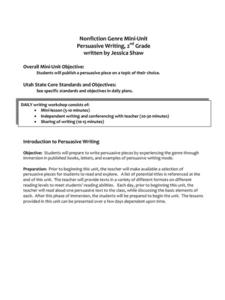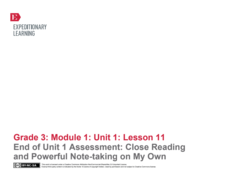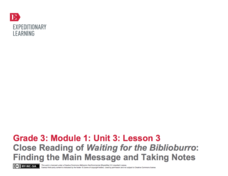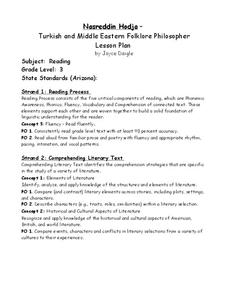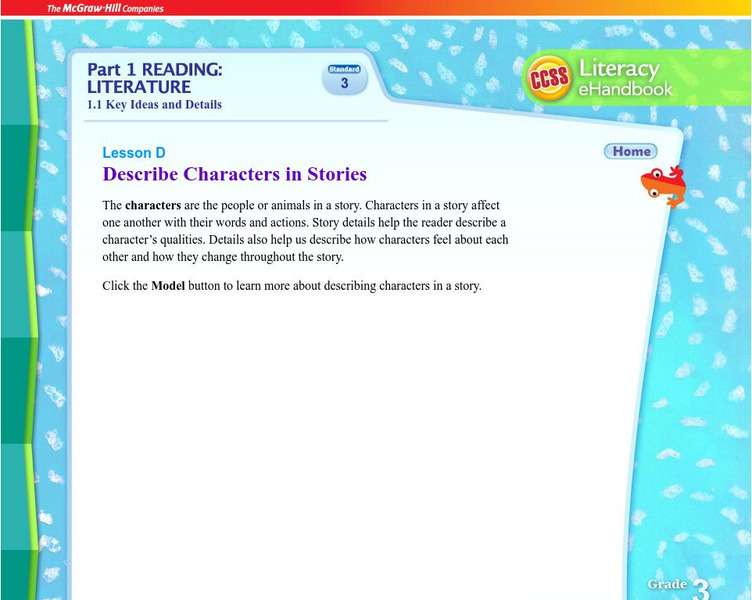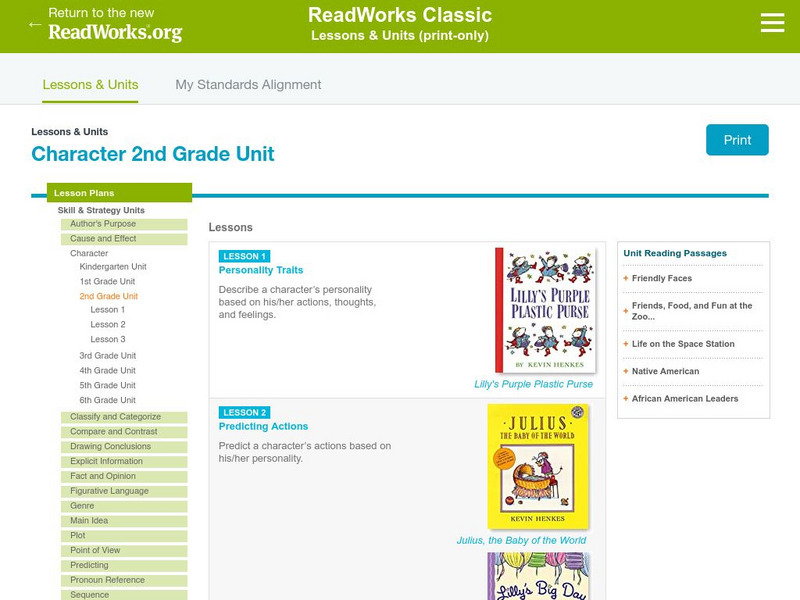Curated OER
Amos and Boris: Text Study
Twenty insightful questions follow a read aloud of the story, Amos and Boris by William Steig. Scholars then show what they know through completion of a cause and effect chart, reading fluency assessment, and a written...
EngageNY
Close Reading of That Book Woman: How Did People Access Books in Rural Areas of the United States?
For this ninth lesson plan in a larger beginning-of-the-year unit, close reading skills are used independently to find the gist of the story That Book Woman. Rereading for important details is the targeted skill to unlock a deeper...
Curated OER
Nonfiction Genre Mini-Unit: Persuasive Writing
Should primary graders have their own computers? Should animals be kept in captivity? Young writers learn how to develop and support a claim in this short unit on persuasive writing.
EngageNY
Close Reading of Nasreen's Secret School: How Do People Access Books in Afghanistan?
Third graders continue to practice the close reading skills of capturing the gist and reading again for important details in the sixth lesson in a larger unit. This is a great beginning-of-the-year unit for establishing visible thinking...
EngageNY
End of Unit 1 Assessment: Close Reading and Powerful Note-Taking on My Own
As the final lesson plan in a larger beginning-of-the-year unit to establish routines and teach close reading skills, this plan is designed as an assessment piece. Using the story, The Librarian of Basra, learners independently...
EngageNY
Close Reading of Waiting for the Biblioburro: Finding the Main Message and Taking Notes
Expose your class to Waiting for the Biblioburro, narrative nonfiction that will act as the bridge between ficiton and informational texts to come. Class members do a close reading of the text, looking at excerpts instead of the whole...
Curated OER
Nasreddin Hodja - Turkish and Middle Eastern Folklore Philosopher
Third graders read a readers theater written by Nasreddin Hodja. In this Nasreddin Hodja lesson plan, 3rd graders learn about the philosopher and participate in one of his reader's theaters.
Curated OER
Character Analysis Lessons
Graphic organizers can be a great tool to help students understand character analysis.
Alabama Learning Exchange (ALEX)
Whales, Whales, Whales!
The title says it all! Help your pupils learn all about whales. Class members research different species of whales and share the information via video conferences with kids from another school. They conduct research on a selected species...
Curated OER
Animal Story: An Informational Narrative
Students use the computer to research information and publish creative narrative stories about the life of a specific Everglades animal. This instructional activity uses many educational, computer programs including the iLife suite,...
Curated OER
Mac Millan: Describe Characters in Stories
This learning module focuses on characters in stories including their actions, changes in character behaviors, and describing character traits. It includes an example passage with questions and answers and a practice passage with questions.
PBS
Pbs Learning Media: Modern Little Red Riding Hood: Video
As you watch this updated story of Little Red Riding Hood, notice the traits, motivations, and feelings of the characters in the story. Check out the additional activities including Guided viewing. Students describe characters in a story...
Florida Center for Reading Research
Florida Center for Reading Research: Check a Trait
A lesson plan in which students read a narrative text and complete a graphic organizer to describe the characters in the story. Materials are included. [PDF]
Read Works
Read Works: Grade 2: Three Lesson Unit: Character
[Free Registration/Login Required] A series of three lesson plans designed to teach students to recognize a character's personality traits, predict a character's actions, and describe a character using rich language. Lessons are based on...
Austin Independent School District
Austin Independent School District: Character Frame [Pdf]
A graphic organizer designed to help students understand characterization by visualizing a character and describing that character's actions and feelings throughout a story.


